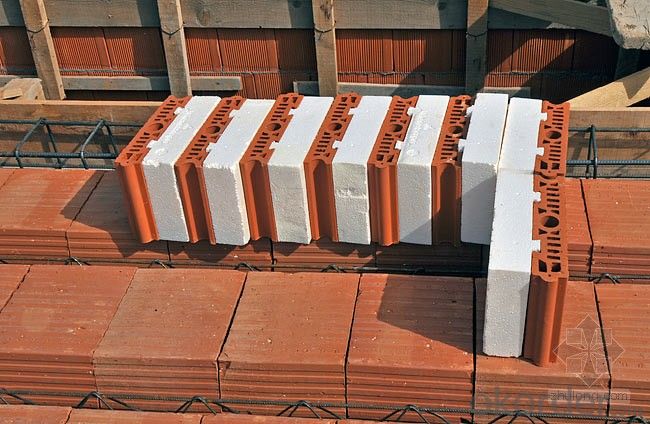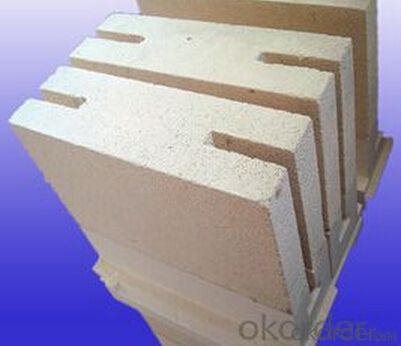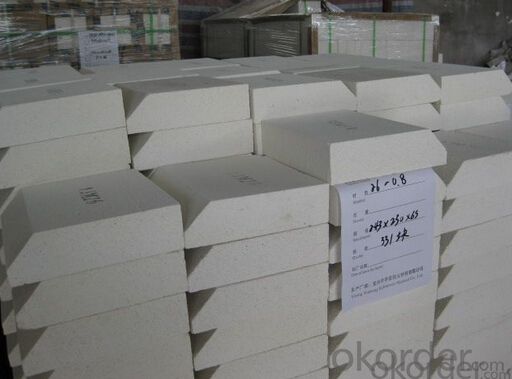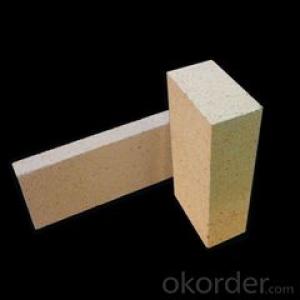Insulating Fire Brick - Refractory Mullite GJM 28
- Loading Port:
- Shanghai
- Payment Terms:
- TT OR LC
- Min Order Qty:
- 5000 kg
- Supply Capability:
- 100000 kg/month
OKorder Service Pledge
OKorder Financial Service
You Might Also Like
OKORDER Series Insulating Bricks
OKORDER series insulating bricks are a kind of highly efficient, energy saving, low-carbon, environmental protection advanced products which are manufactured according to ASTM standard. OKORDER series products are the best lining and insulation materials in all types of industrial furnaces in the field of Metallurgy, Aluminum, Petrochemical, Ceramics, Power and Glass. They can be applied as heat insulation or no-melt erosion parts of the working layer. The products have been widely used in the following furnaces and achieved satisfactory results.
Application of Insulating Bricks
Metallurgy industry: Blast furnace, Hot blast stove, Reheating furnace, etc.
Petrochemical industry: Ethylene cracking furnace, Hydrogen production furnace, Primary reformer furnace, Reheating furnace, etc.
Ceramics Industry: Roller kiln, Pusher kiln, etc.
Glass industry: Glass furnace regenerator, etc.
Carbon Industry: Carbon roaster, etc.
Aluminum electrolytic industry: aluminum reduction cells,etc.
Other industries: Tunnel kiln, Shuttle kiln, etc.
Advantages of Insulating Bricks
Low Thermal Conductivity: More porosity brings excellent insulation effect, energy saving.
High Crushing Strength: High crushing strength under thermal state, volume stability.
Low Heat Storage: Little thermal storage when absorb more heat, energy saving effect is obvious.
High Purity: Low content of iron, alkaline and metal impurities.
Accurate Dimension: Precise brick size by machining, cutting and grinding special shapes, expediting bricklaying.
Picture of Insulating Bricks


FAQ
1. Which products do you have?
We have all kinds of refractory brick, castable, mortar, cement, ceramic fiber products, etc.
Or you could browse our products to choose what you need.
2. How do you control the products quality?
With strict quality control system throughout the materials selection and production process, our refractory and ceramic fiber products quality is effectively controlled to meet customer requirements.
From the raw materials selecting, our quality control begin. The quality certificates of raw materials are required and each batch will be tested before using. During production, the quality control are conducted by workers and then each piece will be sorted and examined by quality supervise.
3. Can you give me a brief introduction of the application of your products?
We are mainly specializing in the refractory materials in iron and steel, cement, glass, ceramics, petrochemical, electric power Industry, etc.
4. If I need your offer, what information do you need?
In order to choose suitable products, it will be appreciated to provide us the information, such us specification, technical data, order quantity, products application etc.
If any question, please contact us freely.
- Q: Can insulating fire bricks be used in ceramic industry kilns?
- Yes, insulating fire bricks can be used in ceramic industry kilns. These bricks are designed to withstand high temperatures and provide excellent insulation, making them suitable for use in kilns where high heat retention and energy efficiency are important.
- Q: Can insulating fire bricks be used in the construction of lime calciners?
- Yes, insulating fire bricks can be used in the construction of lime calciners. Lime calciners require high temperatures to produce lime, and insulating fire bricks are designed to withstand and retain heat. These bricks have low thermal conductivity, allowing them to effectively insulate the calciner and prevent heat loss. Additionally, insulating fire bricks are lightweight, making them easier to handle and install in the construction of lime calciners.
- Q: Are insulating fire bricks suitable for use in incinerators?
- Yes, insulating fire bricks are suitable for use in incinerators. These bricks are designed to withstand high temperatures and provide excellent thermal insulation, making them ideal for insulating the inner walls of incinerators. They help to retain heat, improve energy efficiency, and prevent heat loss, thereby enhancing the overall performance of the incinerator.
- Q: Are insulating fire bricks suitable for insulation in steam boilers?
- Yes, insulating fire bricks are suitable for insulation in steam boilers. Insulating fire bricks are made from lightweight materials that have high insulating properties, such as alumina or silica. They are designed to withstand high temperatures and thermal shocks, making them ideal for use in steam boilers where there is constant exposure to heat. Insulating fire bricks have low thermal conductivity, which means they can effectively prevent heat transfer, reducing energy loss and increasing the efficiency of steam boilers. Their high insulation properties also help to maintain consistent temperatures within the boiler, preventing heat fluctuations and minimizing the risk of thermal stress and damage. Furthermore, insulating fire bricks are resistant to corrosion and chemical attacks, ensuring their durability and longevity in steam boiler applications. They are also easy to install and can be cut into different shapes and sizes to fit the specific requirements of the boiler. Overall, insulating fire bricks are an excellent choice for insulation in steam boilers due to their ability to withstand high temperatures, low thermal conductivity, and resistance to corrosion. They help in reducing energy loss, improving efficiency, and ensuring the longevity of the boiler.
- Q: How do insulating fire bricks contribute to energy efficiency?
- Insulating fire bricks are a type of brick with high thermal resistance, which means they are excellent at preventing heat transfer. This property makes them a valuable component in energy-efficient systems. One way insulating fire bricks contribute to energy efficiency is by reducing heat loss. These bricks have low thermal conductivity, which means they don't easily conduct heat. As a result, they can effectively insulate areas where high temperatures are present, such as furnaces, kilns, and fireplaces. By minimizing heat loss, insulating fire bricks help keep the heat generated in these systems contained, allowing them to operate more efficiently. Moreover, insulating fire bricks also help reduce energy consumption. As they limit heat transfer, less energy is required to maintain the desired temperature within a system. This is particularly important in industries where high temperatures are essential for operations, as it can lead to significant energy savings. By using insulating fire bricks, companies can reduce their energy consumption, resulting in lower utility bills and a reduced environmental impact. Additionally, insulating fire bricks contribute to energy efficiency by improving the overall performance of heating systems. By providing insulation, these bricks help maintain a consistent and controlled temperature within the system. This ensures that the heat is evenly distributed and that there are no energy wastages due to temperature fluctuations. As a result, systems equipped with insulating fire bricks can operate more efficiently and effectively. In conclusion, insulating fire bricks play a crucial role in enhancing energy efficiency. Their high thermal resistance properties help reduce heat loss, minimize energy consumption, and optimize the performance of heating systems. By incorporating insulating fire bricks, individuals and industries can enjoy significant energy savings while also promoting a greener and more sustainable approach to energy consumption.
- Q: Can insulating fire bricks be used in the construction of hearths?
- Yes, insulating fire bricks can be used in the construction of hearths. Insulating fire bricks are designed to withstand high temperatures, making them an excellent choice for hearth construction. They have low thermal conductivity, which helps to retain heat and prevent the transfer of heat to the surrounding areas. This makes them ideal for creating a well-insulated and efficient hearth. Additionally, insulating fire bricks are lightweight and easy to handle, making them convenient for construction purposes. Overall, insulating fire bricks are a reliable and practical option for building hearths.
- Q: Energy saving bricks or bricks?
- Energy saving brick may be cement slag, or cement, water residue, cement, coal ash, etc. overview
- Q: Are insulating fire bricks suitable for outdoor use?
- No, insulating fire bricks are not suitable for outdoor use as they are not designed to withstand the harsh weather conditions and can deteriorate quickly when exposed to moisture and temperature fluctuations.
- Q: Can insulating fire bricks be cut to size?
- Yes, insulating fire bricks can be cut to size using various cutting tools such as saws or knives.
- Q: Do insulating fire bricks require any special cleaning procedures?
- Special cleaning procedures are not necessarily needed for insulating fire bricks. Nevertheless, just like any other substance, they can gather dust, dirt, or debris as time goes on, which may diminish their insulating capabilities. To uphold their effectiveness, it is suggested to occasionally eliminate any loose particles by gently brushing or vacuuming the surface of the bricks. If the bricks come into contact with oil or grease, it is recommended to utilize a mild detergent or soap solution for cleansing the affected regions. In general, consistent maintenance and preventing excessive accumulation will guarantee their optimal performance.
Send your message to us
Insulating Fire Brick - Refractory Mullite GJM 28
- Loading Port:
- Shanghai
- Payment Terms:
- TT OR LC
- Min Order Qty:
- 5000 kg
- Supply Capability:
- 100000 kg/month
OKorder Service Pledge
OKorder Financial Service
Similar products
Hot products
Hot Searches
Related keywords






























